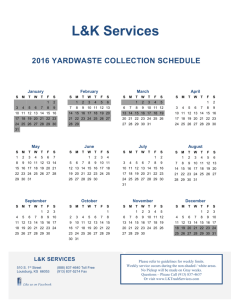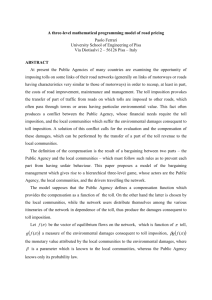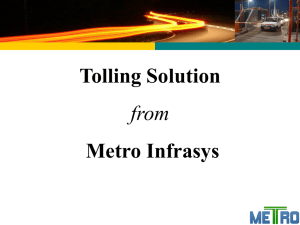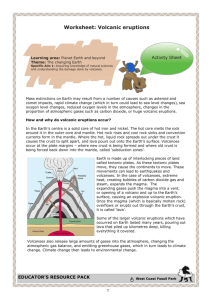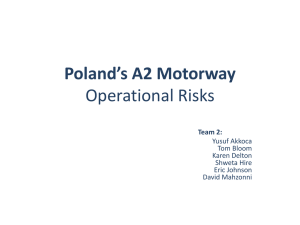Effect of Removing Freeway Mainline Barrier Toll Plazas on Safety
advertisement
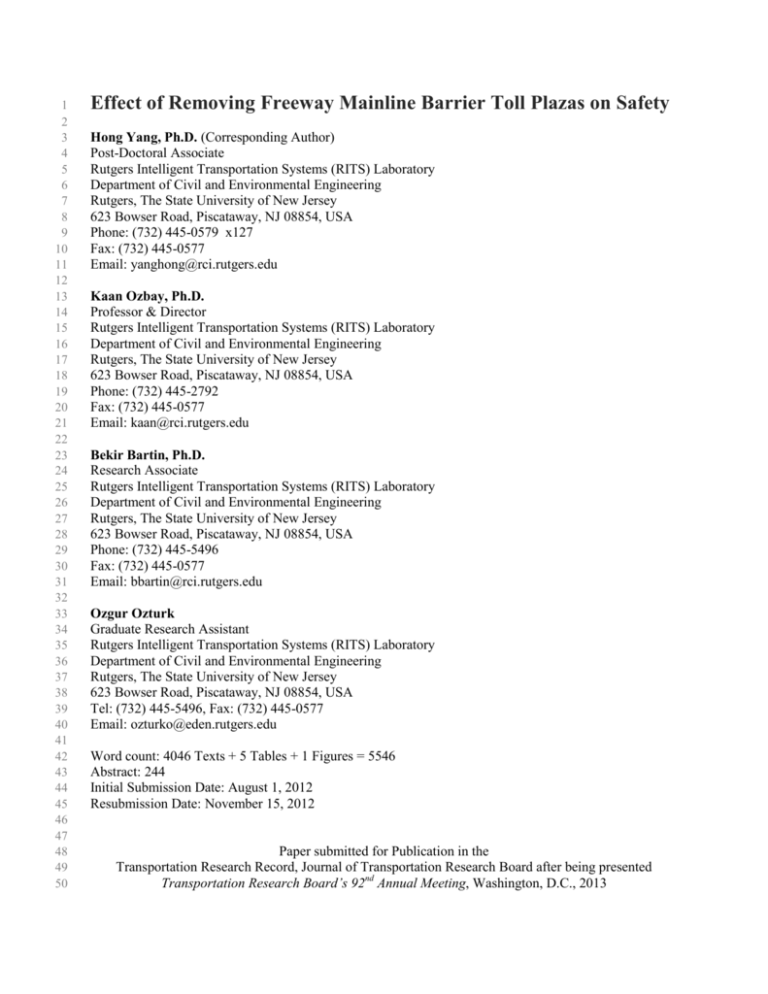
Yang, Ozbay, Bartin, and Ozturk 1 2 3 4 5 6 7 8 9 10 11 12 13 14 15 16 17 18 19 20 21 22 23 24 25 26 27 28 29 30 31 32 33 34 35 36 37 38 39 40 41 42 43 44 45 46 47 48 49 50 1 Effect of Removing Freeway Mainline Barrier Toll Plazas on Safety Hong Yang, Ph.D. (Corresponding Author) Post-Doctoral Associate Rutgers Intelligent Transportation Systems (RITS) Laboratory Department of Civil and Environmental Engineering Rutgers, The State University of New Jersey 623 Bowser Road, Piscataway, NJ 08854, USA Phone: (732) 445-0579 x127 Fax: (732) 445-0577 Email: yanghong@rci.rutgers.edu Kaan Ozbay, Ph.D. Professor & Director Rutgers Intelligent Transportation Systems (RITS) Laboratory Department of Civil and Environmental Engineering Rutgers, The State University of New Jersey 623 Bowser Road, Piscataway, NJ 08854, USA Phone: (732) 445-2792 Fax: (732) 445-0577 Email: kaan@rci.rutgers.edu Bekir Bartin, Ph.D. Research Associate Rutgers Intelligent Transportation Systems (RITS) Laboratory Department of Civil and Environmental Engineering Rutgers, The State University of New Jersey 623 Bowser Road, Piscataway, NJ 08854, USA Phone: (732) 445-5496 Fax: (732) 445-0577 Email: bbartin@rci.rutgers.edu Ozgur Ozturk Graduate Research Assistant Rutgers Intelligent Transportation Systems (RITS) Laboratory Department of Civil and Environmental Engineering Rutgers, The State University of New Jersey 623 Bowser Road, Piscataway, NJ 08854, USA Tel: (732) 445-5496, Fax: (732) 445-0577 Email: ozturko@eden.rutgers.edu Word count: 4046 Texts + 5 Tables + 1 Figures = 5546 Abstract: 244 Initial Submission Date: August 1, 2012 Resubmission Date: November 15, 2012 Paper submitted for Publication in the Transportation Research Record, Journal of Transportation Research Board after being presented Transportation Research Board’s 92nd Annual Meeting, Washington, D.C., 2013 TRB 2013 Annual Meeting Paper revised from original submittal. Yang, Ozbay, Bartin, and Ozturk 1 2 3 4 5 6 7 8 9 10 11 12 13 14 15 16 2 ABSTRACT Toll plaza safety is a critical issue. Toll plazas induce motor vehicle crashes and also put workers such as toll collectors at risk. Therefore, enhancing safety at a toll plaza is crucial to improving safety on tolled roadways. This study aims to evaluate the safety effect of removing mainline barrier toll plazas on highways using Empirical Bayesian (EB) methodology. Recent removals of barrier toll plaza on the Garden State Parkway in New Jersey were used as a case study. Multiple-year traffic and crash data before and after the removals of the barrier toll plazas were used for analysis. Toll plaza crash frequency models as a function of traffic flow and other factors were developed, with the modeling results suggesting that there is a nonlinear relationship between toll plaza crash occurrences and both traffic flow as well as toll booth configurations. The EB approach is also used to predict crash frequency assuming that the barrier toll booths were not removed. These EB-based estimates were compared with the observed number of crashes after the removals of the toll plazas. Individual comparisons show reductions in crash frequency at almost all of the toll plazas and an estimated reduction of 47.2 percent overall at all toll plazas due to the removal of the barrier toll booths. The estimated crash cost was reduced by 43.2 percent. These estimated reductions demonstrate that the removal of barrier toll plazas is a very beneficial step towards improving safety of toll roads. TRB 2013 Annual Meeting Paper revised from original submittal. Yang, Ozbay, Bartin, and Ozturk 1 2 3 4 5 6 7 8 9 10 11 12 13 14 15 16 17 18 19 20 21 22 23 24 25 26 27 28 29 30 31 32 33 34 35 36 37 38 39 40 41 42 43 44 45 46 47 48 49 50 51 3 INTRODUCTION Highway authorities have continued to use advanced technologies to improve efficiency at toll plazas. A first step was the use of automatic coin machines (ACM), and later was the establishment of electronic toll collection (ETC) systems. ETC enables non-stop toll charges via electronic transponders or other forms of automatic vehicle identification (AVI). ETC is widely recognized as a successful Intelligent Transportation Systems (ITS) application with numerous benefits such as lower transaction time, improved throughput, and reduced air pollution and fuel consumption (e.g.,1-4). However, ETC systems on traditional barrier toll plazas still require vehicles to slow down into channeled toll lanes, which itself requires vehicles to make complex lane-choice decisions at relatively high speeds. Therefore, safety issues at barrier toll plazas still exist despite increased throughput. As stated in Brown et al. (5), even though toll plazas have been designed and constructed in the United States for more than 50 years, there are no widely accepted design standards for toll plaza uniformity or safety, with the only standards developed by individual toll operators based on their experience (6-10). It is stated that there has been an increase in the number of toll roadways being built with little information on how such barrier toll plazas affect crash rates (11). Similarly in Abdelwahab et al. (12), the urgent need to study traffic safety issues of toll plazas is emphasized. Removing existing toll plazas can be deemed safer as they eliminate complicate lane-choice decisions as well as the barrier itself as an obstruction, which both increase the likelihood of crashes. However, unlike easily measurable benefits such as reduction of transaction-related delays and pollution, it is difficult to evaluate safety performance of removing the barrier toll plazas after a short period of time. Few studies have briefly analyzed the safety problems created by the presence of toll plazas (13-15). The main objective of this study is twofold: (1) Model the crash occurrence at barrier toll plazas, and (2) Evaluate the safety effects of removing the barrier plazas on toll roads. The removals of mainline barrier toll plazas on the Garden State Parkway in New Jersey are used as a case study. Crash models are developed to investigate the safety performance before and after the removals of the mainline toll booths. The crash data available in this study cover the period from 2001 to 2010. Therefore, safety performance of removing the barrier toll plazas can be analyzed and compared using the multi-year crash data (16). REMOVAL OF MAINLINE TOLL PLAZAS ON FREEWAYS The Gardens State Parkway (GSP) , a 172.4-mile limited-access tolled parkway with 359 exits and entrances, is used as the case study to analyze the impacts of the removals of toll plazas on freeways. The main reasons for selecting GSP as the case study are (1) GSP is a major and heavily congested limited access highway; (2) 10 barrier toll plazas on the mainline have been removed since 2001; and (3) Before and after crash data for GSP is available on-line (16) from the New Jersey Department of Transportation (NJDOT). Over 380 million vehicles travel the GSP which stretches the length of New Jersey (NJ) from the New York (NY) state line at Montvale to Cape May at the southern tip of the state. Tolls are collected at 50 locations, including 11 mainline toll plazas and 39 entrance and exit ramps (17). It is among America’s busiest highways, serving users from NJ and NY’s most marketable communities (18, 19). A traditional low-speed ETC system was deployed on GSP in 1999. The entire system was completed in August 2000 (19). The system has been widely adopted by travelers with an ETC penetration rate beyond 70 percent (20). In 2001, the state government issued an order to promote a ten-year congestion relief plan for GSP (21). Under the plan, elimination of mainline barrier toll plazas in one direction and use of express ETC lanes of open road tolling (ORT) in the other direction were recommended. By 2010, all mainline barrier toll plazas but one were converted to one-way tolling (express ETC lanes were added to both directions at the Toms River toll plaza). TABLE 1 summarizes the toll plaza removal date of each barrier toll plaza. FIGURE 1 shows an example of the progression of removing toll collection at the Pascack Valley northbound toll plaza. The original toll plaza [see FIGURE 1 (a)] was retrofitted to add two express ETC lanes in each direction in 2004, shown in FIGURE 1 (b). Its remaining barrier toll booths TRB 2013 Annual Meeting Paper revised from original submittal. Yang, Ozbay, Bartin, and Ozturk 1 2 3 4 4 were removed in 2010 and the toll plaza becomes a standard roadway section without any toll collection [see FIGURE 1 (c)]. Similar conversions were conducted at the other nine toll plazas in TABLE 1. TABLE 1 Removal of the Mainline Barrier Toll Plazas on GSP Toll Plaza Milepost Removal Date Removed Toll booths Current Lanes Cape May SB 19.4 1/8/2006 5 2 Great Egg NB 28.8 1/8/2006 5 2 New Gretna SB 53.5 1/8/2006 6 2 Barnegat NB 68.9 3/10/2007 7 2 Asbury Park SB 104 9/12/2004 13 5 Raritan NB 125.4 9/12/2004 17 7 Union SB 142.7 3/6/2005 13 6 Essex NB 150.7 7/17/2005 8 4 Bergen SB 160.5 12/4/2005 8 4 Pascack Valley NB 166.1 2/20/2010 6 3 5 (a) Existing toll plaza configuration before 2004 SB 6 NB (b) Adding Express ETC Lanes in 2004 SB NB 7 (c) Removing Northbound Toll Plaza in 2010 SB NB 8 9 10 11 12 13 14 15 FIGURE 1 Toll collection evolution at Pascack Valley Toll Plaza. (Source: Google Map & 22) Removing those traditional barrier toll booths that have served more than fifty years on GSP conceivably eliminates bottlenecks on the freeway. It can improve the highway capacity and reduce emissions related to the heavy stop-and-go traffic at barrier toll booths. By realigning the plaza roadway to allow for smooth traveling, it is deemed to avoid the safety pitfalls of conventional toll plazas. However, the safety benefits of removing the barrier toll plazas have not yet been quantified. TRB 2013 Annual Meeting Paper revised from original submittal. Yang, Ozbay, Bartin, and Ozturk 1 2 3 4 5 6 7 8 9 10 11 12 13 14 15 5 SAFETY IMPACT ANALYSIS Data Description Several data were collected to investigate crash characteristics at the mainline toll plazas. The crash records for toll plazas are obtained from the raw crash database of the New Jersey Department of Transportation (NJDOT) (16). The records provide detailed information on each crash such as the time, location, collision type, and severity. Generally, crash data are analyzed from sections of 0.5 miles or longer (e.g., 23,24). Considering the signposting distances and physical lengths of the toll plazas on GSP, toll plaza impact area is assumed to be one mile, which covers 0.5 mile before and after the toll booths, respectively. Crashes that occurred within the impact area of each toll plaza were extracted from the raw crash records. Data in the year when the toll plaza was removed were excluded for analysis. In addition, the most recently removed toll plaza, Pascack Valley NB toll plaza listed in TABLE 1, was also excluded for analysis. TABLE 2 presents the average number of crashes observed in each year before and after the mainline barrier toll plazas were removed. TABLE 2 Annual Crash Frequency Before-After Removing Toll Plazas With Toll Plaza (Annual Observed Crashes) Toll Plaza 16 17 18 19 20 21 22 23 24 25 26 27 28 29 30 31 32 33 34 35 Without Toll Plaza (Annual Observed Crashes) Period All PDO Injury Period All PDO Injury Cape May SB 2001-2005 6.8 5.4 1.4 2007-2010 3.0 2.0 1.0 Great Egg NB 2001-2005 8.2 7.4 0.8 2007-2010 6.0 5.0 1.0 New Gretna SB 2001-2005 15.2 12.2 3.0 2007-2010 5.3 3.5 1.8 Barnegat NB 2001-2006 22.3 19.0 3.3 2008-2010 23.3 15.3 8.0 Asbury Park SB 2001-2003 52.3 41.7 10.7 2005-2010 25.0 19.7 5.3 Raritan NB 2001-2003 129.0 101.0 28.0 2005-2010 65.8 51.7 14.2 Union SB 2001-2004 182.3 146.5 35.8 2006-2010 130.8 101.8 29.0 Essex NB 2001-2004 67.5 50.8 16.8 2006-2010 35.2 25.2 10.0 Bergen SB 2001-2004 46.8 34.5 12.3 2006-2010 48.2 39.8 8.4 The crash counts shown in TABLE 2 indicate that the crash counts at some toll plazas such as Cape May SB were reduced whereas others such as Bergen SB were increased. However, the observed crash counts before and after the removals of toll plazas should not be directly compared as many casual factors have not been addressed. The GSP toll plaza configurations and annual average daily traffic (AADT) data for the toll plazas between 2001 and 2010 were obtained from the New Jersey Turnpike Authority (NJTA). Empirical Bayesian Analysis Safety assessment is a challenge task. Intuitively, safety effect/impact can be determined like previous studies (25,26) by simply comparing the historical crash frequencies or rates before and after the implementation of treatments at toll plazas: A B or A B , where B is the reported crash frequency or rate in the before period; A is the reported crash frequency or rate in the after period; is the change of crash frequency or rate; and is the index of effectiveness. However, such simple analysis is often unable to clarify the actual effectiveness of the treatment because of the natural change in safety over time. In addition, it is undesirable to predict the index of effectiveness by merely using the observed number of crashes as it does not account for the potential change in traffic volume. Besides, such a simple before-after comparison cannot account for many issues such as regression-to-the-mean effect as well as changes in other casual factors (27,28,29). Therefore better evaluation approaches are necessary to assess the safety effect of the removing the mainline toll plazas. TRB 2013 Annual Meeting Paper revised from original submittal. Yang, Ozbay, Bartin, and Ozturk 1 2 3 4 5 6 7 8 9 10 11 12 13 14 15 16 17 18 19 20 21 22 23 24 25 26 27 28 29 30 31 32 33 34 35 36 37 38 39 40 41 42 43 44 45 6 The methodology adopted herein is the Empirical Bayesian (EB) method. The EB method pioneered by Hauer (27) has been widely recognized as a very effective tool for various observational before-after traffic safety studies (24,30-34). Instead of merely using observed crash counts or rates B in the before period, the essential idea of EB procedure estimates the long-term safety of an entity using two different sets of evidence, that is, the historical crash data of the entity and the predicted number of crashes obtained from a safety performance function ( SPF ) for similar sites (24,35). Compared to other simple before-after evaluation methods, the EB method has some distinct advantages. First and foremost, the EB method offers improved estimates of the expected number of crashes had the treatment not been implemented in the after period by accounting for the regression-to-the-mean effect along with changes in traffic volume and other factors (32,36). In addition, it is preferred as the need of a comparison group is not compulsory (36,37,38). For before-after methods relying on a comparison group, it may be difficult to obtain and appropriately select the comparison group, as discussed in (39,40). The detailed EB procedure is not described in this study, but is well documented in literature (e.g.,27,36,37,41). Only the overall index of effectiveness, its variance, and standard error for the removals of the toll plazas are presented as follows: Aa a 1 Var a a2 1 Aa Var a a2 2 Var 2 1 Var a a2 (1) (2) S .E. Var (3) where is the overall index of effectiveness; a is the expected toll number of crashes based on EB approach had the toll plazas not been removed; Aa is the total number of crashes observed after the toll plazas were removed; Var ( ) represents variance and S .E.( ) represents standard error of . The overall safety effectiveness as a percentage change of crash frequency across all removed toll plazas is 100 1 . The 95 percent confidence interval (CI) for is estimated as 1.96S.E. . If 1 and its confidence interval does not contain 1, then the result implies that the removals of the toll plazas have significantly improved the safety (in terms of crash reduction). In contrast, if 1 and the lower limit of the confidence interval is greater than 1, then the removals of the toll plazas have a negative impact on toll plaza safety (in terms of crash increase). Otherwise, the removals of the toll plazas have no obvious impact on the safety performance of the toll plaza sections. Data from thirteen other mainline toll plazas on GSP that have not been removed between 2001 and 2010 were used to develop the SPF . Specifically, negative binomial (NB) regression models for total crashes, PDO crashes, and injury crashes (combined fatal crashes) were developed to link a set of explanatory variables with crash counts at the toll plazas. The quantifiable variables considered in this study are summarized in TABLE 3. It should be noted that some other variables such as roadway grade, traffic composition and weather conditions may also affect the safety performance of the section. Therefore, if data were available, these variables should be considered in the model. The final safety SPF for predicting the number of crashes at toll plaza can be specified as follows: ln(i ) 0 ln( AADTi )1 ln( AZonei ) 2 3 ln( DZonei ) 4 Boothi 5 ACM i 6CASHi 7 ExETCi 8Yeari (4) where i is the predicted number of crashes at ith toll plaza; 0 is a constant and j ( j 1,2,...,8) represents the coefficient of each explanatory variable. TRB 2013 Annual Meeting Paper revised from original submittal. Yang, Ozbay, Bartin, and Ozturk TABLE 3 Variables Considered for the Safety Performance Functions 1 2 3 4 5 6 7 8 9 10 11 12 13 14 15 16 17 18 19 20 21 22 7 Variable Symbol Description Number of crashes Flow Length of approach zone Length of departure zone Number of toll booths Proportion of exact change toll booths Proportion of cash toll booths Proportion of express ETC lanes Year Y AADT Azone Dzone Booth ACM CASH ExETC Year Annual crashes at a toll plaza (dependent variable) Traffic flow (vehicles) per day per toll booth Length of approach zone of a toll plaza (mile) Length of departure zone of a toll plaza (mile) Total number of toll booths at a toll plaza Proportion of toll booths that primarily use exact change Proportion of toll booths that primarily use cash Proportion of toll booths that primarily use high-speed ETC Order of year in study period to address time trend RESULTS & DISCUSSION The negative binomial (NB) regression models for toll plaza safety analysis were developed by crash categories, with the estimated model parameters presented in TABLE 4. The results show that toll plaza crash frequency is expected to increase with traffic volume. This result is consistent with the common argument in traffic safety studies that more vehicles are likely to cause more unsafe interactions and therefore more crashes (32,42). The length of the approach zone is negatively associated with crash risk. In other words, the crashes can be reduced if a longer approach zone is available. This may be attributable to the fact that the longer approach zone provides more time to safely change lanes and select toll booths. Similarly, the length of the departure zone is also negatively associated with crash occurrence. The more toll booths a toll plaza has, the more crashes are expected to occur. The positive signs of the proportion of low speed toll booths (using cash and exact change payment) indicate that these toll booths were all positively associated with the number of crashes at toll plazas. This is expected as vehicles must slow down and pay tolls with cash at these toll booths. It causes more stop-and-go traffic which in turn increases the crash risk. More importantly, the crash counts will reduce if the proportion of express toll lanes is larger. This is consistent with our previous findings in (43) that the use of high-speed toll lanes (or open road tolling) will significantly reduce the number of crashes. In addition, there was no obvious time trend of crash frequency at the toll plazas. These SPFs are then used to conduct EB estimation of crashes at the removed toll plazas listed in TABLE 2. TABLE 4 Estimates of Coefficients for Safety Performance Functions NB Model Total Crashes Variable Coef. Std.Err P>|z| Coef. Std.Err. P>|z| Coef. Std.Err P>|z| log(AADT) 1.768 0.132 0.000 1.789 0.141 0.000 1.965 0.206 0.000 log(Azone) -0.728 0.157 0.000 -0.690 0.164 0.000 -1.088 0.224 0.000 log(Dzone) -0.509 0.157 0.001 -0.488 0.162 0.003 -0.621 0.196 0.002 Booth 0.174 0.013 0.000 0.170 0.013 0.000 0.173 0.018 0.000 Cash 0.746 0.613 0.223 0.766 0.645 0.235 0.267 0.846 0.753 ACM 0.789 0.492 0.109 0.417 0.509 0.413 1.612 0.563 0.004 ExETC -1.044 0.344 0.002 -1.072 0.359 0.003 -1.141 0.462 0.013 Year 0.017 0.015 0.245 0.020 0.015 0.195 0.005 0.018 0.793 Constant -15.628 1.222 0.000 -15.786 1.300 0.000 -19.809 1.863 0.000 Dispersion 0.083 0.015 --- 0.084 0.016 --- 0.050 0.022 --- TRB 2013 Annual Meeting PDO Crashes Injury Crashes Paper revised from original submittal. Yang, Ozbay, Bartin, and Ozturk 1 2 3 4 5 6 7 8 9 10 11 12 13 8 TABLE 5 presents the results of the Empirical Bayesian (EB) before-after evaluation of removing mainline barrier toll plazas on Garden State Parkway. The total number of observed crashes during the period without the barrier toll plazas is compared with the number of crashes predicted had the toll plazas not been removed. The results show that almost all toll plazas have a significant estimated reduction in crash frequency after the toll plazas have been removed. The index of effectiveness for Barnegat NB toll plaza as well as Bergen SB toll plaza is relatively larger than the others. This indicates that the toll plaza removals at these two sites were less effective than other sites. Detailed crash characteristics should be examined to reveal the reasons why the projects at these two sites were less effective. The overall index of effectiveness for total crashes is 0.528 which implies a crash reduction factor of 100(1 ) 47.2 percent. Similarly, the overall crash reduction factors for PDO crashes and injury crashes are 49.0 percent and 40.3 percent, respectively. TABLE 5 Impact of Toll Plaza Removal based on EB Prediction Without Toll Plaza (observed) 14 15 16 17 18 19 20 21 22 23 24 25 26 27 28 29 30 31 32 33 34 35 36 With Toll Plaza (EB predicted) Index of Effectiveness( ) Toll Plaza All PDO Injury All PDO Injury Overall PDO Injury Cape May SB 12 8 4 28 22 5 0.424 0.350 0.761 Great Egg NB 24 20 4 42 38 10 0.559 0.514 0.390 New Gretna SB 21 14 7 57 46 11 0.361 0.299 0.610 Barnegat NB 70 46 24 78 72 14 0.892 0.632 1.718 Asbury Park SB 150 118 32 373 302 77 0.399 0.388 0.408 Raritan NB 395 310 85 933 742 173 0.422 0.417 0.486 Union SB 654 509 145 1093 891 205 0.598 0.570 0.704 Essex NB 176 126 50 386 296 90 0.455 0.423 0.547 Bergen SB 241 199 42 310 236 72 0.772 0.838 0.573 1743 1350 393 3300 2646 657 0.528 0.510 All Toll Plazas Notes: (1) EB estimate is the expected number of crashes during after period had the toll plaza not been deployed; (2) is estimated index of effectiveness; and (3) Statistically significant is shown in blue number. (4) Observation period for each toll plaza is listed in TABLE 2 0.597 To examine the economic impact of removing the barrier toll plazas in terms of safety cost, benefit cost analysis is conducted. The average economic cost per crash ($8,900 for a PDO crash and $70,200 for an injury crash) estimated by the National Safety Council is used for the analysis (44). The benefit is estimated by production of crash cost with the number of reductions in PDO and injury crashes. If the toll plazas were not removed, the estimated total crash cost is approximately $69.7 million during the after period. In contrast, the estimated crash cost after the removals of the toll plazas is estimated at only $39.6 million in total. Thus the overall crash cost reduction due to the removals of the barrier toll plazas is estimated at 43.2 percent. CONCLUSIONS This study aimed to evaluate the safety effects of removing mainline barrier toll plazas on tolled roadways. The removal of nine barrier toll plazas on the Garden State Parkway (GSP) in New Jersey between 2001 and 2010 was used as the case study. Crash data, related traffic volume data, and lane configurations for each toll plaza were collected to support the analysis. Crash modeling based on the Empirical Bayesian (EB) method was conducted to determine the index of effectiveness of removing the toll plazas. Results of the before-and-after comparisons show that the removals of these toll plazas significantly improved the safety at these locations. The estimated results show that the overall crash occurrence at these toll plazas was reduced by 47.2 percent after the removals of barrier toll plazas. The TRB 2013 Annual Meeting Paper revised from original submittal. Yang, Ozbay, Bartin, and Ozturk 1 2 3 4 5 6 7 8 9 10 11 12 13 14 15 16 17 18 19 20 21 22 23 24 25 26 27 28 29 30 31 32 33 34 35 36 37 38 39 40 41 42 43 44 45 46 47 48 49 50 9 estimated crash cost was reduced by 43.2 percent. The negative safety impacts of the barrier toll plazas are identified as the mixed use of different toll booths at barrier toll plazas, which force drivers to make more lane changes and travel at varying speeds at toll plazas. Frequent lane changes and large speed variations in turn increase the likelihood of crash at these locations. It is thus concluded that the removals of traditional barrier toll plazas can be a beneficial step towards significantly improving safety on the toll roads. Though the analyses focused on removing barrier toll plazas, the findings could be useful to support some other treatments to enhance safety at toll plazas. For instance, if it is impossible to remove a toll plaza, new tolling solutions like open road tolling (ORT) system can be used. Once toll booths are converted to ORT lanes, the tolling function can be kept but the impact on traffic as well as safety can be reduced because there would be no physical barrier toll booths to impede traffic. DISCLAIMER The contents of this paper reflect views of the authors who are responsible for the facts and accuracy of the data presented herein. The contents of the paper do not necessarily reflect the official views or policies of any agencies. REFERENCES 1. Hensher, D.A. Electronic Toll Collection. Transportation Research Part A: General, Vol. 25, Issue 1, 1991, pp. 9–16. 2. Li, J., D. Gillen, and J. Dahlgren. Benefit-Cost Evaluation of the Electronic Toll Collection System: A Comprehensive Framework and Application. Transportation Research Record: Journal of the Transportation Research Board, No. 1659, Transportation Research Board of the National Academies, Washington, D.C., 1999, pp. 31–38. 3. Coelho, M.C., T.L., Farias, and N.M. Rouphail. Measuring and Modeling Emission Effects for Toll Facilities. In Transportation Research Record: Journal of the Transportation Research Board, No. 1941, Transportation Research Board of the National Academies, Washington, D.C., 2005, pp. 136– 144. 4. Venigalla, M. and M. Krimmer. Impact of Electronic Toll Collection and Electronic Screening on Heavy-Duty Vehicle Emissions. In Transportation Research Record: Journal of the Transportation Research Board, No. 1987, Transportation Research Board of the National Academies, Washington, D.C., 2006, pp. 11–20. 5. Brown, L., D.R., McDonald, and E.J. Myers. Developing Traffic Control Strategies at Toll Plazas. ITE Journal, November 2006, pp. 22–26. 6. Schaufler, A.E. NCHRP Synthesis of Highway Practice 240: Toll Plaza Design. Transportation Research Board of the National Academies, Washington, D.C., 1997. 7. McDonald, D. and R. Stammer. Contribution to the Development of Guidelines for Toll Plaza Design. Journal of Transportation Engineering, Vol. 127, No. 3, 2001, pp. 215–222. 8. Al-Deek, H., A. Mohamed, and A. Radwan. New Model for Evaluation of Traffic Operations at Electronic Toll Collection Plazas. In Transportation Research Record: Journal of the Transportation Research Board, No. 1710, Transportation Research Board of the National Academies, Washington, D.C., 2000, pp. 1–10. 9. Stammer, R. and D. McDonald Tollway Sign and Pavement Markings-Recommended Design Guidelines. Transportation Quarterly, Vol. 54, No. 3, 2000, pp. 67–84. 10. Dijk, N., M. Hermans, and M. Teunisse. Designing the Westerschelde Tunnel Toll Plaza Using a Combination of Queuing and Simulation. In Proceeding of the Winter Simulation Conference, Phoenix, Arizona, 1999. 11. Frisbie, T. American Highways Take a Toll. Traffic Safety, Vol. 91, 1991, pp. 22–25. 12. Abdelwahab, H.T. and M.A. Abdel-Aty. Artificial Neural Networks and Logit Models for Traffic Safety Analysis of Toll Plazas. In Transportation Research Record: Journal of the Transportation TRB 2013 Annual Meeting Paper revised from original submittal. Yang, Ozbay, Bartin, and Ozturk 1 2 3 4 5 6 7 8 9 10 11 12 13 14 15 16 17 18 19 20 21 22 23 24 25 26 27 28 29 30 31 32 33 34 35 36 37 38 39 40 41 42 43 44 45 46 47 48 49 50 51 13. 14. 15. 16. 17. 18. 19. 20. 21. 22. 23. 24. 25. 26. 27. 28. 29. 30. 31. 32. 10 Research Board, No. 1784, Transportation Research Board of the National Academies, Washington, D.C., 2002, pp. 115–125. Ozbay, K., and A.M. Cochran. Safety Assessment of Barrier Toll Plazas. Advances in Transportation Studies-An International Journal, Section A. Vol. 12, 2007, pp. 23-33. Mohamed, A.A., M.A. Abdel-Aty, and J. Klodzinski. Safety Considerations in Designing Electronic Toll Plazas: Case Study. ITE Journal, 2001, pp. 20–24. Menta, V., H. Strate, D. Boss, and A. Saracena. Electronic Toll Collection and Safety at the Holland Tunnel. In Conference of Traffic Congestion and Traffic Safety in the 21st Century: Challenges, Innovations, and Opportunities. FHWA/NHTSA, U.S. Department of Transportation, Chicago, Ill., 1997, pp. 236–242. NJDOT. Crash Records. http://www.state.nj.us/transportation/refdata/accident/. Access April, 2012. NJTA. http://www.state.nj.us/turnpike/who-we-are.html. Access April 2012. Travelers’ Marke. Garden State Parkway. Available online at: http://www.travelersmarketing.com/NewJersey.htm. Access July 2011. Currie, J., and Walker, R. (2011). Traffic Congestion and Infant Health: Evidence from E-ZPass. American Economic Journal: Applied Economics, Vol. 3, No. 1, pp. 65–90. NJTA. Financial Summary for the Five Months Ended May 31, 2011. http://www.state.nj.us/turnpike/documents/MonthlyFinancialMay2011.pdf. Access June 2011. Weinstein, J. Garden State Parkway Congestion Relief Plan - A Proposed Framework. Department of Transportation, New Jersey, 2001. Raczynski, R. and J. Finn. Garden State Parkway Plaza Improvement Program. Presented at IBTTA Facilities Management Workshop, Toronto, Ontario, May 14-18, 2005. Resende, P. T. V. and Benekohal, R. F. (1997). Effects of Roadway Section Length on Accident Modeling. Proceedings of the Conference-Traffic Congestion and Traffic Safety in the 21st Century: Challenges, Innovations, and Opportunities, Chicago, IL, June 8-11, pp. 403-409. Abdel-Aty, M., P.C. Devarasetty, and A. Pande. Safety Evaluation of Multilane Arterials in Florida. Accident Analysis & Prevention, Vol. 41, Issue 4, 2009, pp. 777–788. Klodzinski, J., E. Gordin, H.M. Al-Deek. Evaluation of Impacts of Open road Tolling on Main-Line Toll Plaza. In Transportation Research Record: Journal of the Transportation Research Board No. 2012, Transportation Research Board of the National Academies, Washington, D.C., 2007, pp. 72– 83. Gordin, E., J. Klodzinski, and C.D. Santos. Safety Benefits from Deployment of Open Road Tolling for Main-Line Toll Plazas in Florida. In Transportation Research Record: Journal of the Transportation Research Board No. 2229, Transportation Research Board of the National Academies, Washington, D.C., 2011, pp. 85–92. Hauer, E. Observational Before-After Studies in Road Safety: Estimating the Effect of Highway and Traffic Engineering Measures on Road Safety. Pergamon Press, Elsevier Science, Ltd., Oxford, United Kingdom, 1997. Elvik, R. The Importance of Confounding in Observational Before-and-After Studies of Road Safety Measures. Accident Analysis & Prevention, Vol. 34, Issue 5, 2002, pp. 631–635. Shen, J. and A. Gan. Development of Crash Reduction Factors: Methods, Problems, and Research Needs. In Transportation Research Record: Journal of the Transportation Research Board, No. 1840, Transportation Research Board of the National Academies, Washington, D.C., 2003, pp. 50– 56. Persaud, B., E. Hauer, R. Retting, R. Vallurupalli, and K. Mucsi. Crash Reductions Related to Rraffic Signal Removal in Philadelphia. Accident Analysis & Prevention, Vol. 29, Issue 6, 1997, pp. 803–810. Elvik, R.,. The Predictive Validity of Empirical Bayes Estimates of Road Safety. Accident Analysis & Prevention, Vol. 40, Issue 6, 2008, pp. 1964–1969. Monsere, C.M. and E.L. Fischer. Safety Effects of Reducing Freeway Illumination for Energy Conservation. Accident Analysis & Prevention, Vol. 40, Issue 5, 2008, pp. 1773–1780. TRB 2013 Annual Meeting Paper revised from original submittal. Yang, Ozbay, Bartin, and Ozturk 1 2 3 4 5 6 7 8 9 10 11 12 13 14 15 16 17 18 19 20 21 22 23 24 25 26 27 28 29 30 31 32 11 33. Shin, K., S.P. Washington, and I. Van Schalkwyk. Evaluation of the Scottsdale Loop 101 Automated Speed Enforcement Demonstration Program. Accident Analysis & Prevention, Vol. 41, Issue 3, 2009, 393–403. 34. Persaud, B., B. Lan, C. Lyon, and R. Bhim. Comparison of Empirical Bayes and Full Bayes Approaches for Before–After Road Safety Evaluations. Accident Analysis & Prevention, Vol. 42, Issue 1, 2010, pp. 38–43. 35. Wen, C. and S.P. Washington. Experimental Evaluation of Hotspot Identification Methods. Accident Analysis & Prevention, Vol. 37, Issue 5, 2005, pp. 870–881. 36. Hauer, E., D.W. Harwood, F.M. Council, and M.S. Griffith. Estimating Safety by the Empirical Bayes Method: A Tutorial. In Transportation Research Record: Journal of the Transportation Research Board, No. 1784, Transportation Research Board of the National Academies, Washington, D.C., 2002, pp. 126–131. 37. Highway Safety Manual (HSM), 1st edition. American Association of State Highway and Transportation Officials (AASHTO), Washington, D.C., 2010. 38. Elvik, R. Analytic Choices in Road Safety Evaluation: Exploring Second-Best Approaches. Accident Analysis & Prevention, Vol. 45 (March), 2012, pp. 173–179. 39. Hauer, E. Comparison Groups in Road Safety Studies: An Analysis. Accident Analysis & Prevention, Vol. 23, Issue 6, 1991, pp. 609–622. 40. Hauer, E., J.C.N. Ng, and P. Papioannou. Prediction in Road Sfety Studies: An Empirical Inquiry. Accident Analysis & Prevention, Vol. 23, Issue 6, 1991, pp. 595–607. 41. Persaud, B. and C. Lyon. Empirical bayes before–after safety studies: Lessons learned from two decades of experience and future directions. Accident Analysis & Prevention, Vol. 39, Issue 3, 2007, pp. 546–555. 42. El-Basyouny, K. and T. Sayed. Accident Prediction Models with Random Corridor Parameters. Accident Analysis & Prevention, Vol. 41, Issue 5, 2009, pp. 1118–1123. 43. Yang, H., K. Ozbay, and B. Bartin. Effects of the Open Road Tolling on Safety Performance of Freeway Mainline Toll Plazas. In Transportation Research Record: Journal of Transportation Research Board, Transportation Research Board of the National Academies, Washington, D.C., forthcoming, 2012. 44. National Safety Council. Estimating the Costs of Unintentional Injuries, 2010. http://www.nsc.org/news_resources/injury_and_death_statistics/Pages/EstimatingtheCostsofUninte ntionalInjuries.aspx. Accessed May 15, 2012. TRB 2013 Annual Meeting Paper revised from original submittal.

